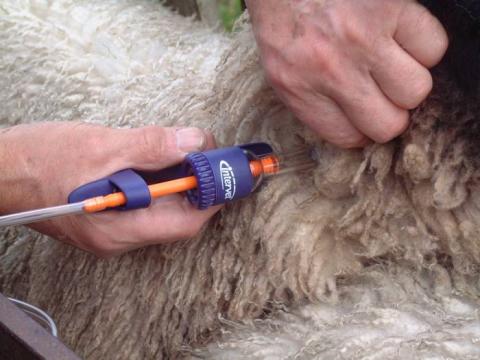Download the table below for details of the different products available for the two options.
Sheep scab should also be considered when quarantining incoming stock to a farm – and now that diagnosis tools are available you can check for the presence of infection rather than just treating in the assumption that incoming sheep have scab. The objective of quarantine treatments is to minimise the chance you will introduce sheep scab and should be applied to all incoming sheep – those purchased from other flocks (including rams) and your own sheep that have been grazing on other farms or common grazing. Click here for information about including scab in a quarantine treatment for worms.
Whether being used for treatment or quarantine purposes, always read the manufacturer’s instructions before use. Withdrawal periods are subject to change and it is the user’s responsibility to ensure withdrawal period is adhered to.
Using a plunge dip
OP dips are a vital tool for scab control – but they must be used responsibly to ensure their effectiveness and ensure mites do not develop resistance to the treatment. OP dips are not authorised for use in showers, jetters or sprayers. Click here for a Code of Practice for mobile sheep dippers, which contains advice for prescribers, farmers and dippers.
Warning to prescribers
- The Veterinary Medicines Directorate (VMD) is clear that prescribers (vets and SQPs) must not prescribe OPs for farmers or contractors to use in showers, jetters or sprayers.
- Prescription by SQPs for such off-label use would be a breach of the SQP Code of Practice, which says SQPs must take into account the requirement for the person receiving the product to use it for an authorised use.
- All prescribers must take into account the need for responsible use of medicines every time a medicine is prescribed. Use in showers or jetters is not generally responsible use and is contrary to the code and cascade on that basis.
- When supplying an OP dip, prescribers are recommended to stress to the buyer that it must not be used in a shower or jetting application. They should not assume they will know this or that using an OP in this could render them liable for prosecution under the Veterinary Medicines Regulations.
- AMTRA will consider disciplinary cases and/or reporting to VMD when made aware of any SQP or business supplying sheep dip contrary to the code or the regulations. Any cases of a vet supplying dip for use in showers/jetters will also be notified to the VMD and RCVS.
- Download the official letter below to SQPs from AMTRA on this topic.
As well as being ‘off label’, parasitologists advise that showering or jetting against scab does not work. It may damp down problems for a while, but won’t help in proper control or eradication, and by sending sheep to market that have been showered/jetted, and carrying ‘hidden’ scab, we may be making the problem in the national flock worse. Showering or jetting with OPs is a waste of farmers’ money and, through exposing scab mites to a sub-lethal dose, could lead to resistance against diazinon developing.
Advice to farmers for using a plunge dip
- Remember OPs are highly toxic and must only ever be purchased and used under the supervision of someone holding an NPTC Certificate of Competence in the Safe Use of Sheep Dips. Container design (closed transfer systems) must be respected, instructions on dosage and administration followed, protective clothing worn and safe storage and disposal practiced.
- If you do not have a Certificate of Competence, contract mobile dippers can provide a valuable service. SCOPS is involved in cross-industry work to develop a new accreditation scheme for dippers to offer assurance to sheep keepers.
- OPs are damaging to the environment and must be used in appropriate facilities and disposed of afterwards with a Disposal Licence. If you are using a contact mobile dipper who takes the waste dip away with them, check they are doing so with the correct procedures in place.
Using an injectable
While a useful tool against sheep scab, the injectable products belong to the 3-ML (clear) group of anthelmintics so also treat roundworms. This means using an injectable to treat a sheep for scab will also expose internal parasites to the active ingredient (moxidectin, doramectin and ivomectin). Resistance of internal parasites to the 3-MLs has increased rapidly in line with increased use for scab, and cases of resistance in scab mites to MLs have now also been recorded. Therefore, these considerations should be made before using an injectable
- Is it definitely scab? Get a diagnosis
- What impact will using an injectable have on my control plan for roundworms? Speak to your vet or animal health advisor about this.
- What is the right dose and do I need to give one or two treatments with the product? Check the manufacturer’s guidance for this.
- Is clean pasture post-treatment needed? And/or you need to give one or two treatments with the product.
There is a guide to using injectable scab treatments available to download below.
If you use a product and think it has not cleared the sheep scab (i.e. sheep are still itchy) you should report this to your vet or merchant. They have been supplied with a simple protocol to take you through to ensure correct diagnosis and to avoid unnecessary re-treatment – more information here. Don’t just dive in and re-treat.
Downloads
Download a product guide to treatment options for scab control.
Download a guide to best practice use of injectable scab treatments.



